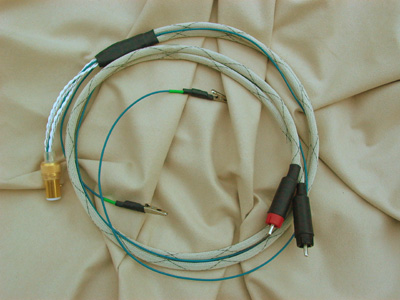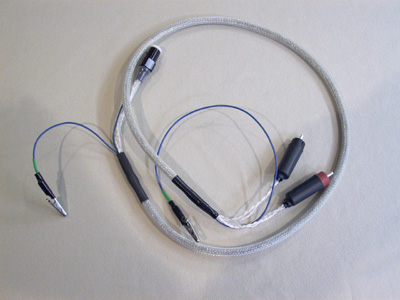You are reading the older HTML site
Positive Feedback
ISSUE
22
audiopath cables
Phono 2, 3, and 4 phono cables
as reviewed by Larry Cox

|
LARRY COX'S SYSTEM
LOUDSPEAKERS
ELECTRONICS
SOURCE
CABLES
ACCESSORIES
|
AudioPath cables are hand made by Tom Hills, personally—no elves at the North Pole involved. They're well made, if not as 23rd-century looking as, say, Nordost cables. They are finished in the way that $1500 handmade Italian shoes look finished but handmade. Tom Hills has been around the audio scene for a while, running his own audio repair and retail store in New York. He has recently gotten into producing cables and importing gear. He's got lots of experience and is knowledgeable, but not so filled with his own knowledge as to dismiss others'. That's a welcome breath of fresh air in an industry loaded with hubris and arrogance.
I got to know Tom because he is the new importer of Moerch tonearms. He also imports Eurolab turntables and FJ speakers. Last year at Christmas time, I reentered analog waters by purchasing a Moerch DP-6 from Tom, though I was still trying to decide which turntable to purchase. Tom told me that he had a used Amazon Model Two hanging around. I had reviewed this table, and liked its sound as well as its looks, so I took the leap. While the Eurolab turntables were less expensive, and featured detached motors that had the potential for better sound, my wife preferred the looks of the Amazon, so the Eurolab didn't stand a chance.
As we were arranging this purchase, Tom asked me if I had a tonearm cable for the Moerch, and offered Moerch's or one of his own. I had no idea which to choose. How does one make such decisions without listening? I had never heard a Moerch arm with either cable, so I was at a loss. With the usual analog DIN plug at the tonearm end, I couldn't just try the interconnects I already had. When I asked Tom for guidance, he said that the Moerch cable was good, but that even the designer of the Moerch arms thought that Tom's more expensive cables were better. I asked if I could listen to several of his cables, and write an article about the process. Tom agreed, so here's my feedback.
Common to all of the Audiopath cables is:
-
A high quality DIN connector
-
Silver Eichmann Bullet RCA jacks at the preamp end (copper Eichmann Bullets are also available)
-
Silver internal wire
-
Braiding used to facilitate shielding
-
Tinned, flexible shielding to reduce RFI
-
Ground wires at both ends of the tonearm cable, so you can ground whichever end makes the most sense, or both if you are extra nervous
The Phono 2 ($275) is made from eight strands of solid core, 22-gauge, pure silver wire. The Phono 3 ($375) is made from the same wire, but uses two wires for each of the four male lugs on the cartridge. The Phono 4 ($450) repeats the construction of the Phono 3, but again uses twice the number of wires, yielding four wires per lug on the cartridge. There will not be a Phono 5 any time soon, as Tom says that the amount of wire used in the Phono 4 is very hard to get into the DIN plug.
I spent a couple of months listening to these cables, trying one for a couple of weeks, then another. Among the records I played during the review period were ones by Gerry Mulligan, Count Basie, and Ella Fitzgerald. I also played The Clash, Steve Forbert, Genesis, Cat Stevens, New Order, X, the Eagles, and Dan Fogelberg, plus pieces by Beethoven, Mozart, and Benjamin Britten. I used four particular LPs to assess the cables:
Grieg's Piano Concerto No. 1 in A Minor. This is a personal favorite for the scale of music, for the complexity of the musical lines, and for its emotionality.
Doug Macleod's Come to Find. I played the title track for its simple guitar and male voice—a good test for imaging.
Linda Ronstadt's What's New? This was the most obviously beautiful-sounding of the test records, though it also presented an opportunity to listen for massed strings, rather than a mass of sound from strings.
New Order, Power, Corruption and Lies. The track “Your Silent Face” has synthesized bass that is deeper than that of most acoustic instruments. I also listened to this track for the purity of its upper midrange.
All of the Audiopath cables had a family sound. Entry-level products often attempt to provide detail by accentuating transients or tipping up the midrange balance up. This was not the case with the Audiopath Phono 2. I started listening with my turntable and preamp plugged into my older API power conditioner and the rest of the system plugged into a PS Audio Power Director 3.5. It sounded like the system had gotten soft and that transients were lost. There was more silence in the adagio passages of the Grieg piece, but it also seemed that low-level signals were obscured. This was a step backward. Returning all of the system connections to the PS Audio brought better transients and blacker backgrounds.
The Phono 2 has an even balance, with a tonality slightly on the warm side of neutral. Thankfully, it didn't pull every detail out of the recording at the cost of washing out the beauty and tonality of the music. The Phono 2 has a less hyped-up treble, and a less thin midrange than other inexpensive tonearm cables. It's a good sound. In a dull or soft system, it will probably not impress, as it will not provide false sheen. However, in an evenly balanced system, you'll hear more of what's going on in the rest of your system. As a result, more of the life that comes with an even tonal balance will shine through.
The Phono 2 comes up short in the imaging department. Left to right imaging was good, but images were wanting in dimensionality. Transients were rounded off, dynamics less clearly rendered. I also wanted to hear more space around instruments. The sound was slightly congealed. I heard a single sound rather than that of a collection of instruments playing at the same time in the same space. Nevertheless, I listened to the Phono 2 almost as long as I listened to the Phono 3 and 4, because I liked the sound so much that I temporarily forgot about the other cables.

Silver 2
When I switched to the Phono 3, the first thing I heard was greater resolution. The music had a lighter touch, with fine detail more clearly presented. The background was quieter, which let notes decay more slowly. Three-dimensional Imaging improved, without losing any left-to-right precision. Linda Ronstadt sounded sweeter, more delicate, and more beautifully portrayed. The strings on What's New sounded more like separate entities than a mass of sound. The improvements were incremental rather than major leaps, but they made it possible to enjoy the Phono 3 a bit more than the Phono 2. Its lighter touch gave a greater sense of separation between instruments, but not as much as the very best equipment allows. Along with the finer drawing of lines came an increased sense of rhythm, though still not quite enough for this cable to be completely satisfying.
With the Phono 4, I heard the same tonal balance, but greater bass depth and texture. An even finer-tipped pen was writing the musical lines. This time, more power came through, along with greater clarity. The Grieg piece had more weight and a better sense of locomotion. The tympanis in the opening were deeper and tauter, and had greater sense of speed. I liked this a lot. Linda Ronstadt's voice was not encapsulated in glycerine, but had the simple, delicate beauty of a well-trained voice. Nelson Riddle's strings now sounded like live strings. The music had that finer line that tells you that very low-level information is being conveyed. Doug Macleod now sounded like he was all by himself in the studio. On the New Order LP, all of the starts and stops of this synthetic music were rendered clearly. It now sounded like synthesized music, which killed it somewhat. I'm not sure that people who like synthesized music would want a high-resolution system.
What was missing? The tinest filigree of nuance—more like the shadows behind the musical images than the music itself. I wasn't sure whether this shortcoming was due to the tonearm cable or something else in my system. Maybe it was van den Hul's retipping of my Koetsu Rosewood, which was not yet fully broken in. I felt that I still had some distance to go in creating “perfect” sound, but that I had gotten further down the road.
The Phono 4 is quite accomplished, and worth looking into for those with better turntables. For my money this, is the way to go. My relatively expensive analog front end remains modest compared to what's available, and I could certainly use more examples to find an exact placement in the phono cable hierarchy for the Phono 4, but it makes no obvious missteps. Its detail, imaging, and tonal balance are quite good. There may be better phono cables out there, but I am content with the Phono 4.
The Phono 3 performs at nearly the same level as the Phono 4, but gives up some bass and a bit of resolution. If I hadn't heard the Phono 4, maybe I'd have stopped at the Phono 3. The Phono 2 is a great entry-level cable, and certainly an upgrade from the cable that comes with your table. It will be welcome in most entry-level analog front ends, and entry level systems, though it will be more interesting in systems that do not have a tipped-up tonal balance. In brighter systems, or ones that accentuate detail, it may under perform. Depending on your system, one of these cables will be well worth looking into. Larry Cox
Phono 2
Retail: $275
Phono 3
Retail: $375
Phono 4
Retail: $450
Hudson Audio
web address:
www.hudsonaudio.com
